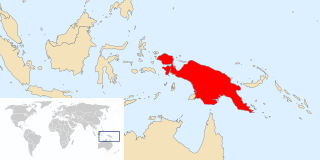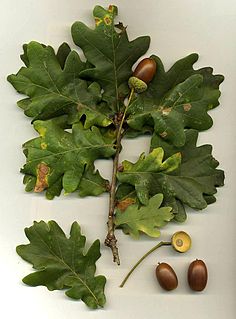
A frond is a large, divided leaf. In both common usage and botanical nomenclature, the leaves of ferns are referred to as fronds and some botanists restrict the term to this group. Other botanists allow the term frond to also apply to the large leaves of cycads and palms (Arecaceae). "Frond" is commonly used to identify a large, compound leaf, but if the term is used botanically to refer to the leaves of ferns and algae it may be applied to smaller and undivided leaves.

Matteuccia is a genus of ferns with one species, Matteuccia struthiopteris. The species epithet struthiopteris comes from Ancient Greek words, στρουθίων (strouthíōn) "ostrich" and πτερίς (pterís) "fern".

The order Cyatheales, which includes the tree ferns, is a taxonomic division of the fern class, Polypodiopsida. No clear morphological features characterize all of the Cyatheales, but DNA sequence data indicate the order is monophyletic. Some species in the Cyatheales have tree-like growth forms, but others have rhizomes.
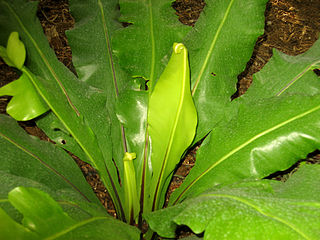
Asplenium nidus is an epiphytic species of fern in the family Aspleniaceae, native to tropical southeastern Asia, eastern Australia, Hawaii, Polynesia, Christmas Island, India, and eastern Africa. It is known by the common names bird's-nest fern or simply nest fern.
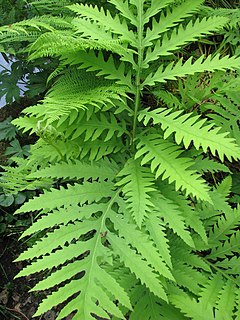
Onoclea sensibilis, the sensitive fern, also known as the bead fern, is a coarse-textured, medium to large-sized deciduous perennial fern. The name comes from the observation by early American settlers that it was very sensitive to frost, the fronds dying quickly when first touched by it. It is sometimes treated as the only species in Onoclea, but some authors do not consider the genus monotypic.
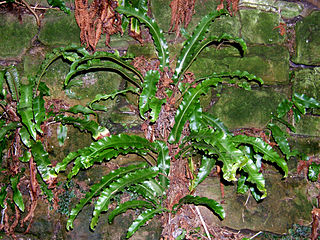
Asplenium scolopendrium, known as hart's-tongue or hart's-tongue fern is a fern in the genus Asplenium, of the Northern Hemisphere.

Pteridium aquilinum, also known as eagle fern, and Eastern brakenfern, is a species of fern occurring in temperate and subtropical regions in both hemispheres. The extreme lightness of its spores has led to its global distribution.

Gymnocarpium dryopteris is a deciduous fern of the family Cystopteridaceae. It is widespread across much of North America and Eurasia. It has been found in Canada, the United States, Greenland, China, Japan, Korea, Russia, and most of Europe.

Athyrium filix-femina, the lady fern or common lady-fern, is a large, feathery species of fern native throughout most of the temperate Northern Hemisphere, where it is often abundant in damp, shady woodland environments and is often grown for decoration.
Aglaomorpha fortunei, commonly known as gu-sui-bu, is a species of basket fern of the family Polypodiaceae. The plant is native to Eastern Asia, including eastern China.

Tmesipteris the "hanging fork fern", is a genus of fern-like vascular plants, one of two genera in the family Psilotaceae, order Psilotales . Tmesipteris is restricted to certain lands in the Southern Pacific, notably Australia, New Zealand and New Caledonia. In New Zealand this hanging epiphyte is common in the warm temperate rain forests of both main islands, where it can normally be found as short spiky dark-green fronds, often with lighter bag-like sporangia at the bases of some of its "leaves". The plant possesses no true leaves; what appear to be leaves are flattened stems. The fronds emerge directly from the fibrous root-mats which clad the trunks of mature tree ferns such as Dicksonia and Cyathea. Tmesipteris is from the Greek language, meaning a "cut fern", referring to the truncated leaf tips.
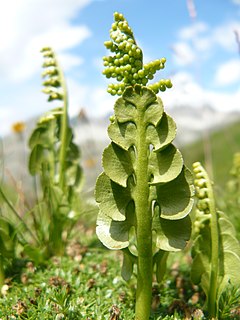
Botrychium lunaria is a species of fern in the family Ophioglossaceae known by the common name moonwort or common moonwort. It is the most widely distributed moonwort, growing throughout the Northern Hemisphere across Eurasia and from Alaska to Greenland, as well as temperate parts of the Southern Hemisphere.

Aglaomorpha meyeniana is a species of plant in the Polypodiaceae family. It is native to the Philippines.
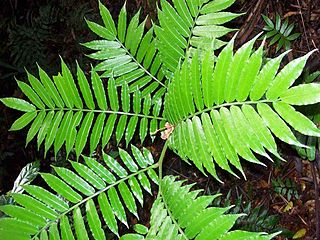
Angiopteris evecta, commonly known as the giant fern, is a rare plant occurring in eastern and northern Australia and the Malay Peninsula. Also found growing in nearby islands such as Borneo, Sumatra, New Guinea and various places in Polynesia, Melanesia and Madagascar. Listed as endangered in New South Wales, where it has been recorded growing in sub tropical rainforest, in the valley of the Tweed River. It is an invasive species in Hawaii and Jamaica.
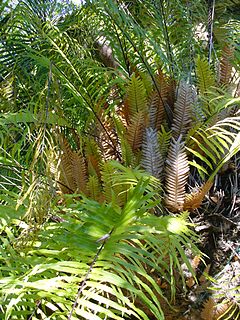
Aglaomorpha is a genus of ferns in the subfamily Drynarioideae of the family Polypodiaceae. The Pteridophyte Phylogeny Group classification of 2016 uses this genus name, while other sources use Drynaria to include Aglaomorpha. Species are commonly known as basket ferns. As circumscribed in PPG I, the genus contains around 50 species.

Drynarieae is a tribe of ferns belonging to the subfamily Polypodioideae of the family Polypodiaceae. Its members are characterized by dimorphic fronds. It contains around 35 species and two genera:

Polypodioideae is a subfamily belonging to the fern family Polypodiaceae. The subfamily name Polypodioideae has two recent uses. The first by Mabberley, 2008, included a larger group of polygrams,, which included six tribes, one of which, Polypodieae, is considered to be a synonym of the more recent sense of Polypodioideae by Christenhusz et al., 2011, in which Polypodiaceae contains five subfamilies, including the smaller Polypodioideae subfamily.

Polypodium is a genus of between 75-100 species of true ferns, widely distributed throughout the world, with the highest species diversity in the tropics. The name is derived from Ancient Greek poly (πολύ) "many" + podion (πόδιον) "little foot", on account of the foot-like appearance of the rhizome and its branches. They are commonly called polypodies or rockcap ferns, but for many species unique vernacular names exist.



